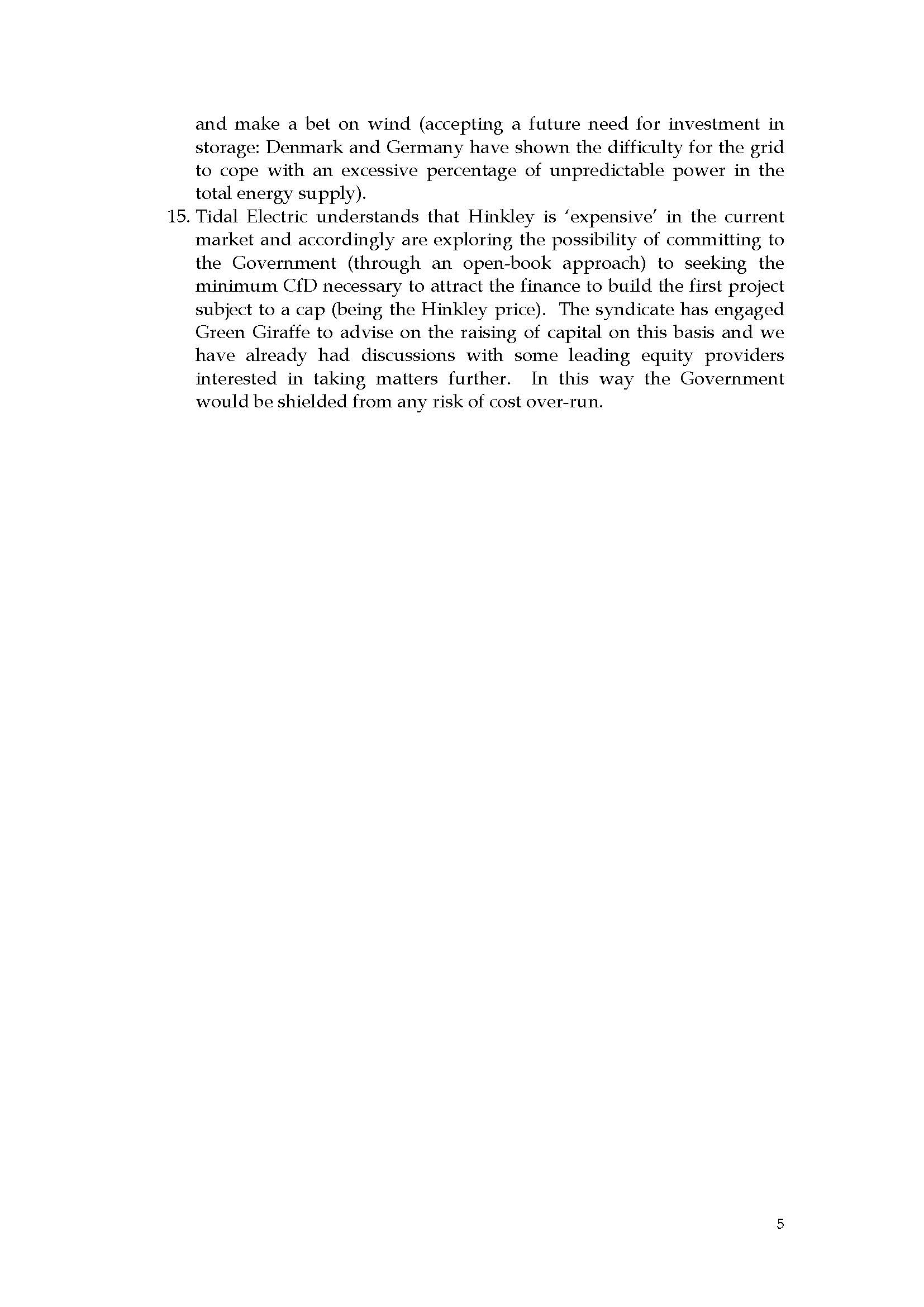Tidal Electric is exploring the potential for a 500 MW project in Mexico that will utilize the pumped storage capacity of its impoundment and incorporate output from local solar and wind projects. Tidal power, solar power, and wind power are all intermittent, but by storing the output from all three renewable sources, the combined generation can be dispatched as firm power, and not need back-up, thereby relieving the demand for back-up from the grid and raising the revenue for all three types of power.
Tidal Electric's submission to the Hendry Review is linked below, along with several relevant documents.
As the patent holder of the (offshore) tidal lagoon technology, Tidal Electric has some significant criticisms of the Swansea Bay TLSB proposed scheme. They are detailed in the following public letter to the the DECC in response to their request for comment on the TLSB proposal.
TO DECC Re: Swansea Bay Tidal Lagoon: potential support for the project through the CFD mechanism
The Government is seeking responses to their proposal that they enter into negotiations for a CFD for a proposed plant in Swansea Bay.
A. Introduction
a. DECC is aware that Tidal Electric Limited (“TEL”) was the first proponent of an offshore power-plant generating power from the rise and fall of the water within an enclosed impoundment. The chosen site for the first ‘test’ plant was Swansea Bay. “Tidal Lagoon” is an informal term first used by Friends of the Earth campaigner Neil Crumpton in about 2000 to refer to the awkwardly-named “offshore tidal generation technology” developed and patented by TEL. Tidal Electric and the media adopted the term. The “offshoreness” of this technology is its key (viz. patented) characteristic: being completely detached from the shore affording environmental and economic benefits.
b. DECC is also aware that TEL first engaged with Mark Shorrock, who was then the managing director of Low Carbon Tidal, to jointly prosecute this proposal in Swansea Bay. After TEL shared its IP and connections, Low Carbon Tidal reneged on its obligations and was put into involuntary liquidation. Mark has resurfaced as managing director of Tidal Lagoon Power (TLP) which is the sole proponent of this current scheme being considered for Swansea Bay: TEL has no connection with proposal continuing to prefer its own design.
B. The Potential of Tidal Lagoons in the UK.
We agree with everything highlighted in this section other than the implication (in 3.4 of the paper above) that lagoons represent an ancillary source of power to the Severn Barrage: the building of a barrage would reduce the tidal range downstream (i.e. the low tide would be higher and the high tide lower) and since the power is a function of the square of the range, any subsequent building of a barrage would likely render pre-existing lagoons uneconomic.
C. The Swansea Bay project
a. The TLP project proposal is an impoundment attached to land, once referred to as a “Russell lagoon,” a concept analysed and rejected by DTI back in the 1950s and rejected again during the 1973-87 Severn Barrage studies as impractical.
b. Without being able to see the technical review (referred to in 4.1 of the paper above) undertaken by an independent third party as to the technical feasibility of the TLP project it is difficult to comment. If that investigation were limited to the feasibility of generating power from the rise and fall of water in an impoundment then we would of course agree.
If that investigation were to confirm the estimated power we would need to understand a great deal more:
i. Our design for Swansea Bay was limited to a 5km square impoundment and predicted generation of 0.18 terawatt-hours p.a. (DECC has had sight of our forecasts). Our design claims a 36% load factor requiring installation of 60MW capacity.
ii. The TPL lagoon is 12km square and claims to generate 0.5 terawatts p.a. It is claiming to require 320MW capacity which would result in an 18% load factor (less than in conventional barrages).
iii. Given that the tidal range is the same, the power outputs of the two designs should be proportional to the footprint of each. This would suggest the TLP plant would produce 0.43 terawatt-hours p.a. at a load factor of 15%..... or would only need to install 145 Mw capacity if they were able to match our load factor and so ……..one of us is wrong.
D. The TLP project is not FOAK (First Of A Kind) because Korea’s Shiwa Tidal project was put in service in 2013, using the same configuration: tidal-range generation from water impounded by a wall touching the shore at each end. The turbines were conventional low-head ‘bulb’ turbines (installed by Andritz). Smaller-scale tidal power schemes connected to shore have been in use for thousands of years, albeit for mechanical power, not for conversion to electrical power.
TEL’s offshore tidal power generation scheme proposal for Swansea Bay is truly FOAK and is ready for deployment.
E. Establishing a Value for Money case.
If the negotiations for any CFD is “likely to be based on whether the CFD would provide the developer appropriate returns in relation to the project” then the cost structure would need to be examined with some care:
a. Given the estimation of power to be generated being 0.5 terawatts p.a. then the price to be set will be lower than if (we are right and) the actual power generated were lower.
Since the CFD, if granted, would be negotiated prior to construction and power-delivery DECC must be confident that the possible decision not to build (if/when the over-estimation of generation is discovered by those providing the construction capital) or the possible bankruptcy of the company ((if/when the over-estimation of generation is discovered through lower generation and the capital cannot be properly service) will not compromise the objective to see “generation from a tidal lagoon at Swansea Bay contributing to the UK’s 2020 Renewable Energy Directive target to deliver 15% of energy from renewable sources”.
b. The TLP design touches the shore and is therefore accessible to the public. The inherent Health & Safety ramifications incur significant costs over and above the TEL design, specifically in terms of width of the impoundment and height above the high-water levels. Were the TEL structures to be adopted these costs would be saved resulting in significant savings to the CFD levels required. Furthermore, the TLP design goes beyond Health & Safety measures to promote potential tourist attraction. The DECC proposal is not clear that these costs would be excluded when seeking to find a CFD that would give “the developer appropriate returns”.
F. The Environmental Case
The benefits from an environmental perspective to generation of power from renewable and predictable sources are high and we would expect analysis to support that. However, one must also look at the costs of environmental damage (if any). Without pre-judging the outcome of any planning application, it is generally accepted that the major environmental problem with Russell Lagoon designs is the damage they cause to the environmentally-rich inter-tidal zone: because the impoundment touches the shore the area of the shore that is wet at high-tide but dry at low-tide - the inter-tidal zone - will be affected. Parsons Brinkerhoff have estimated the cost of replacing such a resource elsewhere, if damaged, could equal the cost of building the impoundment wall! TEL’s off-shore lagoon design avoids this problem.
G. The Approach
a. TEL is confident its designs for off-shore lagoons could deliver power at a cost of £40/MWh.
b. We acknowledge however that TPL is much more advanced in its proposal and it would be difficult to DECC to consider TEL a competitive provider at this point.
CONCLUSION
Provided 7.4 (of the paper above) is adhered to, namely that “ if it is not possible to negotiate a contract (including a strike price for this technology) that meets our value for money considerations and that is acceptable to both parties, discussions would be terminated” and taking account of our points in E and F above, then we see nothing wrong with DECC proceeding as it suggests and enter bi-lateral negotiations.
As for transparency it would be good to see the technical analysis mentioned in D above.
A hydro project in Swansea Bay has gained planning consent. This is a positive step forward for renewables in the UK, and tidal range technology in particular. However, Tidal Lagoon Swansea Bay's scheme has some significant economic, engineering, and feasibility issues which we will detail in the next post.
Southern Alaska is home to some of the richest tidal electricity resources in the world. An initial geotechnical study from Tidal Electric has indicated that there may be more than 3600 MW (11.3 Billion kWh/yr) of immediately addressable capacity in the region, largely clustered in Bristol Bay and Cook Inlet.
The resources located in these areas would provide a mixture of direct-use electricity both for the Railbelt region and for rural markets as well as electricity for distribution to inland markets and export to outside markets.

















